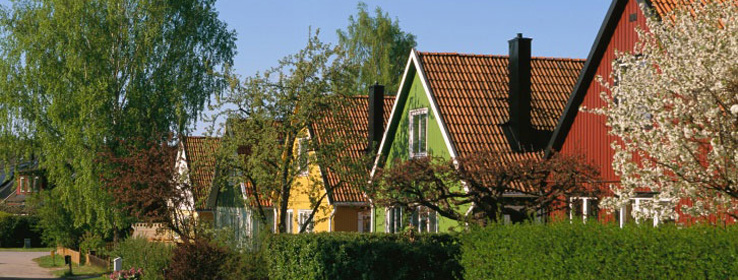New Urbanism-inspired communities are anything but neutral.
When developer Matt Press set out to create a new community in the college town of Bloomington, Ind., he had no idea his homes would simply be referred to by their color. Residents at South Dunn Street need no address; they just say they live in "the purple house" or "the white one with bright orange trim" and people know exactly where to head. In turn, it's given Press a much easier way to introduce himself, by simply saying, "I'm the developer of all those colorful homes."
In planning his colorful community, Press was very much inspired by New Urbanism, an architectural movement founded in the 1980s that strives to be the alternative to suburban sprawl and decay. Typically these neighborhood-based developments offer design-driven homes, often complete with yards and porches, within walking distance to parks, schools, shops and restaurants. New Urbanism's goal is to create more-vibrant living spaces for people who want modern amenities and good construction without having to sacrifice the urban experience.
"New Urbanism got its start from looking at suburbia and decrying its failings," Press says. "The first among those was the lack of color."
Prior to World War II, Bloomington, like many other cities in the United States, had lots of wooden and clapboard homes painted in a number of colorful tones. Then came the proliferation of aluminum and vinyl siding, which provided excellent exterior protection, but did not hold paint very well. Builders found that the color was quick to fade, so they began painting the siding in softer shades, blanketing the cities and suburbs in whites, beiges and grays.
"For about 50 years we lost color on homes," says Press, who feels that the vinyl-clad world has had a numbing effect on our society.
If "sameness" is one of New Urbanism's biggest pet peeves, then differentiating homes and developments with color is the perfect antidote. At South Dunn Street, reintroducing color was critical. In fact, it was "the second most important thing after architecture," according to Press.
He used paint to make a historical reference in his Bloomington neighborhood, hoping to maintain the integrity of the city's colorful past yet offer something unique for the residents. Homeowners get to pick the colors for their exterior's body and trim. There are no limitations or restrictions on choices, which enables them to really take ownership and pride in their home while also carefully considering how their home interacts with the environment around them.
"There is an emotional reason why people buy into my development," Press says. People have used words like "magical" when they talk to Press about the community. He knows color plays a big role in that enthusiasm and says he's thankful to have "hit a nerve in this town in a very positive way."
Original South Dunn Street dwellers got creative coordinating their exterior bases and trims, distinguishing themselves from each other as well as borrowing ideas, like the popular Sherwin-Williams Colonial Yellow (SW 0030) and Scanda (SW 6529) blue combination. (This Swedish-inspired color combination reflects the vibrant Scandinavian row houses that initially inspired Press.)
While color is at the very core of New Urbanism, it's not always used with a liberal hand. Restraint can very often be the best way to make a historical reference in certain locations.
For instance, brick has long been used in Washington, D.C., on everything from urban town homes to stately colonials. Developers and advocates of New Urbanism have tried to replicate that aesthetic when building new communities in the area, in contrast to South Dunn Street. Press agrees, "It would be inappropriate for a New Urbanist to use such vibrant colors in suburban Maryland or Virginia."
Created back in 1981, the pristine beachfront community of Seaside, Fla., is considered the first New Urbanist development. It gained nationwide attention when it was featured in the 1998 film The Truman Show. Its clean palette of pale pastels, whites and creams were chosen as a nod to the late Victorian architecture that used to dot Florida's beachfront towns.
Steve Filmanowicz, communications director for the Congress of New Urbanism, frequently sees designers and architects adjust their palettes according to location, deciding where to use restraint or where to get colorful. He cites the Katrina Cottages in New Orleans as a great example of a new design that fits appropriately into the landscape, architecture and colors of coastal Mississippi.
"New Urbanists are aware of regional traditions," Filmanowicz says. "When they're creating a neighborhood, they're reviving that."
Originally designed as a dignified alternative to the FEMA trailer for victims of Hurricane Katrina, the premise of the Katrina Cottage was to create a house that was safe and affordable, could be built quickly, and yet was still attractive. Since their debut in late 2006, Katrina Cottages have since evolved into a nationwide sensation and are finding popularity as affordable housing, guesthouses, resorts and camps. Several designers participated in the conception of the Katrina Cottages, including Marianne Cusato, who did the iconic bright yellow house, and Miami-based architect Steve Mouzon. Despite the number of designers involved and the variety of styles deployed, the homes still have a cohesive look since the focus remained on rebuilding the community, not just showcasing a specific house.
"The decision of color should be made based on the neighborhood, not the individual building," Mouzon says.
Mouzon, an advocate of New Urbanism, recently wrote A Living Tradition, which examines architecture and the use of color in the Bahamas. He found that the closer homes got to one another, the more sensitive they needed to be about color choice. In other words, homes need to work together to represent the neighborhood as a whole and offer a sense of place, which he notes is not just Bahamas-specific.
Typically location, climate, soil, vegetation and economics all play a role in color choice, whether the community is historic or newly planned. In cooler climates, such as Scandinavia and England, row houses are painted in vibrant, vivid shades to stand out in the often cold, gray climate. In Santa Fe, N.M., the adobe homes are earthy pastels that literally blend into the desert landscape. In busy, crowded city centers, grays and metallics help evoke a contemporary urban vibe.
Not all developments designed using the principles of New Urbanism incorporate the colors of the rainbow, but nearly all of them provide vibrant alternatives to suburbia's builder beige. "Color can assist in both place-making and culture-making," Mouzon says. "It can be far more important if we allow it to be."










